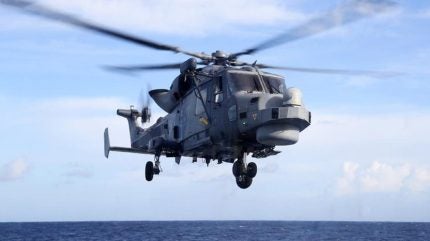
Leonardo UK has proposed its AW159 Wildcat rotorcraft as a solution to the New Zealand Defence Force (NZDF) as a solution for its Maritime Helicopter Replacement (MHR) programme.
At the end of April 2023, the NZDF put forward a request for information for a prospective platform to replace its eight SH-2G(I) Seasprite helicopters that have been in service for the last ten years.

Discover B2B Marketing That Performs
Combine business intelligence and editorial excellence to reach engaged professionals across 36 leading media platforms.
New Zealand’s MHR programme comprises a medium naval helicopter, through-life support solutions, training system solutions, misison support systems, system integration sevrices and uncrewed aerial systems (UAS).
As part of its offer, Leonardo will establish a Wildcat Support Centre in Auckland, in the north of the country. In additon, the company pledges that the agreement would provide a major investment in skills, design and manufacturing, sustainment of jobs for local businesses and potential opprotunities for veterans.
AW159 features
Leonardo designed the Wildcat from concept as a multi-role ‘organic air’ helicopter with ship/air interface characteristics and compact dimensions for single spot deck operations.
A Leonardo UK spokesperson told Naval Technology that it recognises that the Royal New Zealand Navy (RNZN) has a unique set of requirements for its maritime helicopters, which are an integral capability of its ANZAC frigates, offshore patrol vessels, and larger vessels.

US Tariffs are shifting - will you react or anticipate?
Don’t let policy changes catch you off guard. Stay proactive with real-time data and expert analysis.
By GlobalData“With its design from the outset being targeted at small ship operations in challenging maritime environments, the AW159 is the right platform for RNZN, being able to operate across the full range of aviation missions undertaken by the RNZN.”
The twin-engine AW159 is able to conduct missions ranging from constabulary to military conflict where it has the capability to autonomously detect, identify and attack targets on land and at sea, including submarine threats.
It also includes a Leonardo Seaspray multi-mode electronically-scanning radar and integrated electronic warfare defensive aids suite, and is fully network-enabled – a key request given the the Navy’s desire to interoperate alongside the navies of other Five Eyes nations.
28 units of the Future Lynx – later renamed the AW159 in April 2009 – have been in service with the UK Royal Navy since 2012.
The UK Ministry of Defence Future Lynx programme replaced the Royal Navy Lynx HMA.8 and HAS.3, as well as the British Army Lynx AH Mk7 and AH Mk9 helicopters, which entered service in the 1970s. The AW159 is a more capable helicopter with reduced whole-life costs.
“There is a well-established relationship between the Royal Navy and RNZN with ongoing, close collaboration and knowledge-sharing,” the Leonardo spokesperson noted. “The operation of the same platform brings the possibility of greater naval synergy, building upon and strengthening the existing ties and broadening and increasing the opportunities for knowledge sharing and mutual support.”





